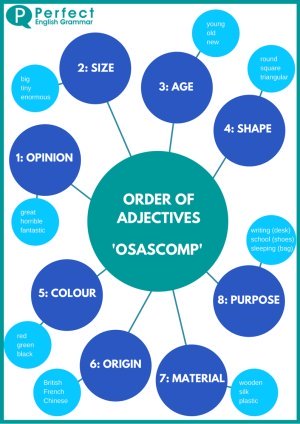Download this explanation in PDF here.
When we use more than one adjective before a noun in English, we often put the adjectives in a specific order. It can sound quite strange if the adjectives are in a different order. However, there are two things to remember. First, it's very rare to use more than three adjectives before a noun. Second, sometimes the order can be changed, usually to emphasise something.
Here is the order that we generally follow:
- Opinion: pretty, horrible, lovely
- Size: huge, tiny, big, little
- Age: old, young, new
- Shape: round, square, triangular
- Colour: black, red, yellow
- Origin: British, Chinese, French
- Material: woollen, wooden, silk
- Purpose: writing (paper), school (shoes)
The first letter of these words spell 'OSASCOMP' (as pointed out by the fabulous Mignon Fogarty) and thinking about the word 'osascomp' is a great way to remember the order of adjectives.
Determiners (words like 'a' or 'some' or' several') go at the beginning. We also put adverbs like 'really' and 'very' at the beginning, after the determiners.
Here are some examples:
- I carried a very small black suitcase.
- They have some old French paintings.
- She was wearing a new red silk dress.
- That is a really ugly wooden chair.
- We bought a new round kitchen table.
- There are some new Chinese students in the class.

